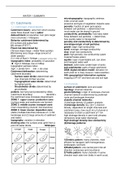Samenvatting
HWM10303: water 1 summary book and lectures
- Instelling
- Wageningen University (WUR)
C1: Catchments 1.1 catchment characteristics 1.2 channels 1.3 climate 1.4 rainfall-runoff processes 1.5 storage 1.6 discharge 1.7 hydrograph 1.8 water balance C2: Groundwater 2.1 groundwater usage 2.2 layers and soil properties 2.3 groundwater level 2.4 isohypes and equipotential li...
[Meer zien]




